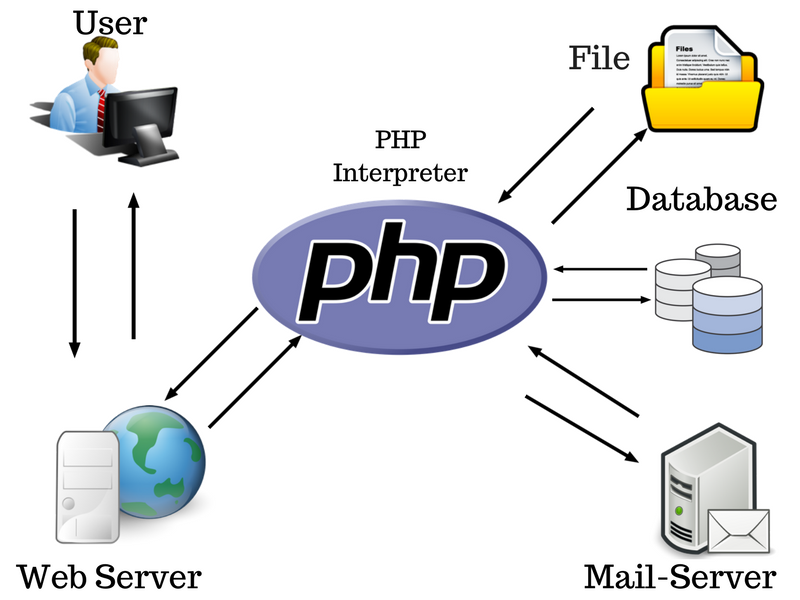CSE 154
Lecture 17: Intro to PHP
XKCD 869Administrivia
HW3 due Monday
Introduction to Module 4 and PHP!
Review: Web Services
Web service: software functionality that can be invoked through the internet using common protocols
It's like a remote function(s) you can call. Done by contacting a program on a web server
- Web services can be written in a variety of languages
- Many web services accept parameters and produce results
- Client contact the servier through the browser using XML over HTTP and/or AJAX Fetch code
- The service's output might be HTML but could be text, XML, JSON, or other content
Some Web Services We've Used as Clients
Merriam-Webster Dictionary API
NASA APOD API
CSE154 web services:
- groupizer.php
- pizza.php
- pokedex.php and game.php
- wpl.php
- mowgliscafe.php
Wednesday's WPL Example
Used to show a few input validation methods before sending
a request to the wpl.php web service.
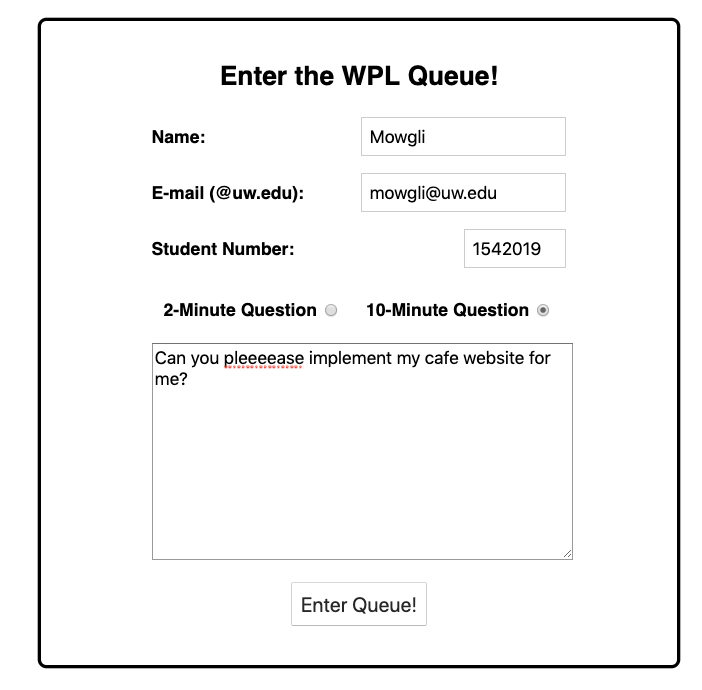
Sending a Request
Once we've validated the input a bit, the request is sent and we recieve a response from
wpl.php

Motivating the Client-Server Relationship
We've used the analogy of a customer (client) ordering from a waiter at a restaurant (server). In this analogy, what might a customer ask for from "GET" request? What might a "POST" request be?

Image source (a wonderful reading to explain front-end vs. back-end/server relationships)
Client (JS) GET Request
function requestMenu() {
let url = RESTAURANT_URL;
url += "?menu=all";
//fetch by default is a GET request
fetch(url)
.then(checkStatus)
.then(JSON.parse)
.then(handleResponse)
.catch(handleError);
}JS
Client (JS) POST Request
function sendOrder() {
let url = RESTAURANT_URL;
let params = new FormData();
params.append("name", "Mowgli");
params.append("order", "coffee");
params.append("qty", 154);
fetch(url, {method: "POST", body: params})
.then(checkStatus)
.then(JSON.parse)
.then(handleResponse)
.catch(handleError);
}JS
How Does a Web Service (like wpl.php or cafe.php) Respond to Requests?
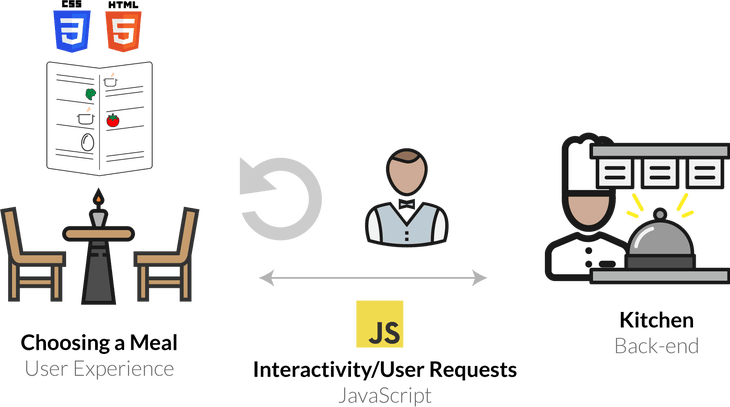
CSE 154 Modules: Where We're At
- Webpage structure and appearance with HTML5 and CSS.
- Client-side interactivity with JS DOM and events.
- Using web services (API's) as a client with JS.
- Writing JSON-based web services with PHP.
- Storing and retreiving information in a database with MySQL and server-side programs.
URLs and Web Servers
https://server/path/fileUsually when you type a URL in your browser:
- Your computer looks up the server's IP address using DNS
- Your browser connects to that IP address and requests the given file
- The web server software (e.g. Apache) grabs that file from the server's local file system and then send back its contents to you
Some URLs actually specify programs that the web server should run, and then send their output back to you as the result:
https://webster.cs.washington.edu/cse154/quote.php
The above URL tells the server webster.cs.washington.edu to run the
program quote.php and send back its output
Why Do We Need a Server to Handle Web Service Requests?
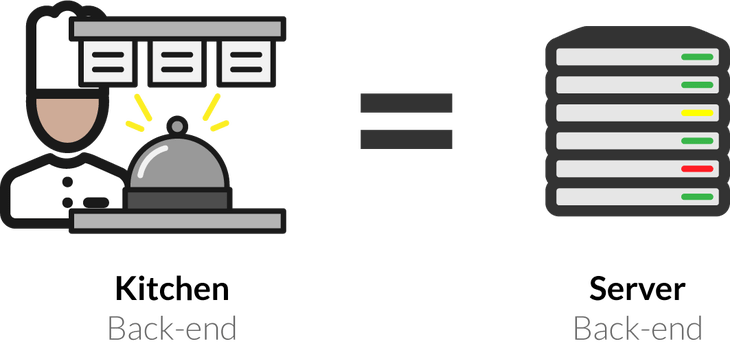
Servers are dedicated computers for processing data efficiently and delegating requests sent from many clients (often at once).
Thinking back to the restaurant transaction analogy, what kind of information:
- should be accessible to clients to freely request ("GET")?
- might be useful for a client to update ("POST") on the server?
- might need to be kept private on the server?
Languages for Server-Side Programming

Server-side programs are written using programming languages/frameworks such as:
Web servers (including those you setup yesterday) contain software to run those programs and send back their output.
PHP: Our Server-Side Language
- Open-source
- Widely supported
- Few dependencies (already ready-to-go with MAMP!)
- You can explore other server-side languages after this course!
Lifecycle of a PHP Web Request
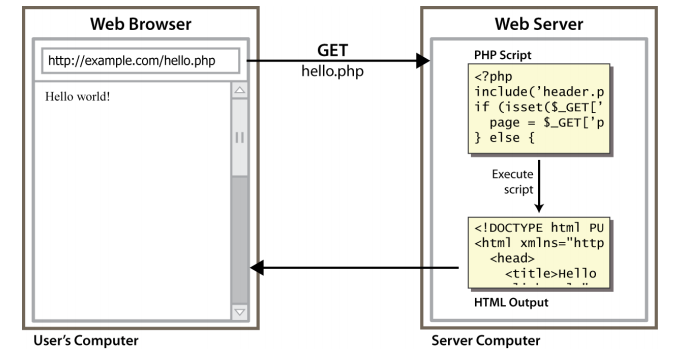
When a browser requests:
- a
.htmlfile (static content): server just sends that file - a
.phpfile (dynamic content): server reads it, runs any script code inside it, then returns the output (possibly as JSON/text/HTML)
Note: We will be using PHP to write web services, not embedding it in HTML - you will see this still in some online resources (what do you think are limitations to embedding PHP in HTML, knowing what we've learned so far?)
JS vs. PHP
| JS | PHP | |
|---|---|---|
| Language Type | Client-side Scripting | Server-side Scripting |
| File Extension | .js | .php |
| Code Execution | Web Browser | Web Server |
| Access to File System | No | Yes |
| Access to Database | No | Yes |
Getting started with PHP
You will have PHP installed already with your MAMP local server So you should be ready to go!
When practicing PHP, you can also find it useful to play around with the interactive PHP mode on a the command line, which is analogous to the Chrome JS console (see slide below).
Handy Interactive Mode in PHP (Command Line)
When first learning the syntax of PHP, it can be helpful to use an "interactive
environment", which is very similar to the interactive JavaScript console we've used.
You can start an interactive coding session using php -a:

Writing/Running .php Files with MAMP
Editing PHP: Atom (just like you've been doing already)
Running/viewing PHP: You can view the output of a .php program in the browser (through localhost) - MAMP must be running!
- Remember to edit your PHP/other code in the folder MAMP points to
so you can run them through locahost:
- Mac:
localhost:8888/php-practice.php - Windows:
localhost/php-practice.php
- Mac:
You can also fetch the output with a
request to your PHP program the same way you've done with other web services as a client
(more next week)!
The PHP file skeleton
PHP files must start with <?php an end with ?>. It is
common to forget these when you're first starting PHP, so make sure to start each file
with them! Anything PHP statements inside will be executed when the program is ran.

The Basics of PHP
Now that we've got a way to run PHP code, let's get started with the basics!
We've provided a php-examples.php program in
php-examples.zip with examples for variables/types/functions in PHP - try
uncommenting the different statements and changing them to practice with the new syntax!
We'll get through Strings today but will review the rest of the examples (arrays, if/else,
loops, and functions) on Monday.
Console Output: print/echo
There are two ways to print in PHP (you may use either, as long as you're consistent):
print "text";
echo "text"; PHP (template)
print "Hello, World!\n";
echo "Escape \"chars\" are the SAME as in Java!\n";
echo "you can have
line breaks in a string.";
echo 'A string can use "single-quotes". It\'s cool!';PHP (example)
The following two slides demonstrate this program in both interactive mode and running the program. Try both out on your own!
Console Output: Interactive Mode

Console Output: Running console-output.php

Note: By default, your PHP will output to the body of the HTML page (check the
inspector!). Since we aren't using PHP to output HTML, we will often use
header("Content-type: text/plain"); at the top of our PHP program to output
plain text (otherwise we won't get the \n character in our output in this example)
Comments
# single-line comment
// single-line comment
/*
* multi-line
* comment
*/PHP
Like Java, but # is allowed
- A lot of PHP code uses
#comments instead of// - We recommend
#and will use it in our examples
Arithmetic Operations
+ - * / %
. ++ --
= += -= *= /= %= .=
Many operators auto-convert types: 5 + "7" is 12
Variables
$name = expression;PHP (template)
$user_name = "Pokemon4Lyfe";
$age = 25;
$age_in_dog_years = $age / 7;
$this_class_rocks = true;PHP (example)
Names are case-sensitive; separate multiple words with _ (as in
$user_name)
Names always begin with $ on both declaration and usage
Implicitly declared by assignment (type is not written; a "loosely-typed" language)
Types
Basic types:
integer
,
float
,
boolean
,
string
,
array
,
object
,
NULL
Test what type a variable is with is_type functions, e.g. is_string
gettype function returns a variable's type as a string (not
often needed)
PHP converts between types automatically in many cases:
stringtointauto-conversion on+for("1" + 1 == 2)inttofloatauto-conversion on/for(3 / 2 == 1.5)
Type-cast with (type):
$age = (int) "21";
String Type
Can be specified with "" or ''
$favorite_food = "coffee!";
echo $favorite_food[2]; # prints "o"PHP
0-based indexing using [] bracket notation
String Concatenation
Important note! String concatenation is .
(period) not +
5 + "2 turtle doves"produces 75 . "2 turtle doves"produces "52 turtle doves"
Seriously. You will make this mistake at least once. It's ok :) just add it to your list of "common PHP bugs" (yes, you might want to start a list).
More PHP Syntax Examples
(Will review for first part of Monday, but included for practice over the weekend
String Functions
# index 012345678901
$name = "Mowgli Hovik";
$length = strlen($name); # 12
$index_of_h = strpos($name, "H"); # 7
$last = substr($name, 7, 12); # "Hovik"
$name = strtoupper($name); # "MOWGLI HOVIK"PHP
| Name | Java Equivalent |
|---|---|
| strlen($str) | str.length |
| strpos($str, $ch) | str.indexOf(ch) |
| substr($str, $start, $end) | str.substring(start, end) |
| strtolower($str), strtoupper($str) | str.toLowerCase, str.toUpperCase |
| trim($str) | str.trim() |
| explode($delim, $str), implode($delim, $arr) | str.split(delim), String.join(delim, values) |
See slides below for Java and Python equivalents!
PHP vs. Java Strings
# index 012345678901
$name = "Mowgli Hovik";
$length = strlen($name); # 12
$index_of_h = strpos($name, "H"); # 7
$last = substr($name, 7, 12); # "Hovik"
$name = strtoupper($name); # "MOWGLI HOVIK"PHP
# index 012345678901
String name = "Mowgli Hovik";
int length = strlen($name); # 12
int indexOfH = name.indexOf("H"); # 7
String last = name.substring(7, 12); # "Hovik"
name = name.toUpperCase(); # "MOWGLI HOVIK"Java
Interpreted Strings
$age = 16;
echo "You are " . $age . " years old.\n";
echo "You are $age years old.\n"; # You are 16 years old.PHP
Strings inside " " are interpreted
- Variables that appear inside them will have their values inserted into the string
Strings inside ' ' are not interpreted:
echo 'You are $age years old.\n'; # You are $age years old.PHP
If necessary to avoid ambiguity, you can enclose the variable in {}:
echo "Today is your $ageth birthday.\n"; # ageth not found
echo "Today is your {$age}th birthday.\n";PHP
bool (Boolean) Type
$feels_like_summer = FALSE;
$php_is_rad = TRUE;
$student_count = 217;
$nonzero = (bool) $student_count; # TRUEPHP
PHP has similar "truthy/falsy" properties as JS (more details)
The following values are considered to be FALSE (all others are
TRUE):
- 0 and 0.0
- "", "0", and
NULL(includes unset variables) - arrays with 0 elements
FALSE prints as an empty string (no output); TRUE prints as
a 1 (why do you think that is?)
For Loops
for (initialization; condition; update) {
statements
}
PHP (template)
for ($i = 0; $i < 10; $i++) {
print "$i squared is " . $i * $i . "\n";
}
PHP (example)
(remember . not + for string concatenation)
If/Else Statements
if (condition) {
statements;
} else if (condition) {
statements;
} else {
statements;
}
PHP (template)
Can also use elseif instead of else if
While Loop (same as Java)
while (condition) {
statements;
}
PHP (template)
do {
statements;
} while (condition);PHP (template)
break and
continue
keywords also behave as in Java (do not use these in this course)
Functions
function name(parameterName, ..., parameterName) {
statements;
}PHP (template)
function calculate_profit($cost, $price, $qty) {
return ($price / $cost) * $qty;
}PHP (example)
- parameter types and return types are not written
- a function with no return statements is implicitly "void"
Calling Functions
name(expression, ..., expression); PHP (template)
$qty = 154; # quantity
$bagel_price = 0.85; # A plain bagel costs .85 to make!
$bagel_sell = 3.50; # A plain bagel sells for 3.50!
$profit = calculate_profit($bagel_cost, $bagel_price, $qty);
# Who needs a degree when you can sell bagels?PHP (example)
Practice
Write a
function named repeat that accepts a string and a number of repetitions as
parameters and returns the string concatenated that many times.
For example, the call of repeat("hello", 3) returns "hellohellohello". If the number of repetitions is 0 or less, return an empty string.
Arrays
$name = array(); # create
$name = array(value0, value1, ..., valueN);
$name[index] # get element value
$name[index] = value; # set element value
$name[] = value; # append PHPPHP
$a = array(); # empty array (length 0)
$a[0] = 23; # stores 23 at index 0 (length 1)
$a2 = array("some", "strings", "in", "an", "array");
$a2[] = "Ooh!"; # add string to end (at index 5) PHP
- to append, use bracket notation without specifying an index
- element type is not specified; can mix types
Associative Arrays
Associative arrays are arrays that use named keys that you assign to them.
$age = array("Spot"=>16, "Whitney"=>16, "Jack"=>12); # create
$age["Mowgli"] = 1;
PHP
$a = array(); # empty array (length 0)
$age["Whitney"] = 17; # stores 17 at the location where "Whitney" is stored
PHP
Array Functions
| Function name(s) | Description |
|---|---|
| count | number of elements in the array |
| print_r | print array's contents |
| array_pop, array_push, array_shift, array_unshift | using an array as a stack/queue |
| in_array, array_search, array_reverse sort, rsort, shuffle | searching and reordering |
| array_fill, array_merge, array_intersect, array_diff, array_slice, range | creating, filling, filtering |
| array_sum, array_product, array_unique, array_filter, array_reduce | processing elements |
Array Function Example
$tas = array("CA", "MJ", "MG", "SK", "KC", "DH", "JZ");
for ($i = 0; i < count($tas); $i++) {
$tas[$i}] = strtolower($tas[$i]);
} # ("ca", "mj", "mg", "sk", "kc", "dh", "jz")
$conner = array_shift($tas); # ("mj", "mg", "sk", "kc", "dh", "jz")
array_pop($tas); # ("mj", "mg", "sk", "kc", "dh")
array_push($tas, "kt"); # ("mj", "mg", "sk", "kc", "dh", "kt")
array_reverse($tas); # ("kt", "dh", "kc", "sk", "mg", "mj")
sort($tas); # ("dh", "kc", "kt", "mg", "mj", "sk")
$ks = array_slice($tas, 2, 3); # ("kt")PHP
The array in PHP replaces many other data structures in Java
- e.g. list, stack, queue, set, map, ...
The foreach loop
A convenient way to loop over each element of an array without indices
foreach ($array as $variableName) {
...
}
PHP (template)
$pups = array ("Mowgli", "Abby", "Archie", "Pascal");
foreach ($pups as $pup) {
echo "Mowgli boops $pup\n"; # even himself
}
PHP (example)

